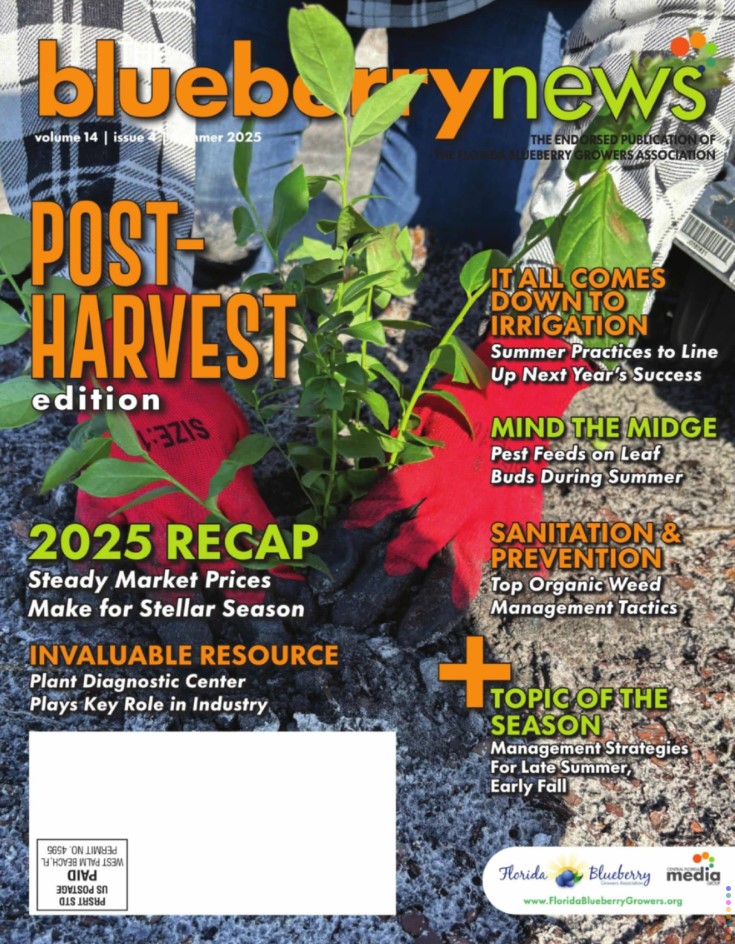The summer growth that occurs in Florida blueberry fields following post-harvest pruning contains most of the fruiting wood for next year’s crop. Therefore, it is important that conditions are suitable to support strong, healthy, vegetative growth throughout the summer. Irrigation and fertilization are two important practices that contribute to healthy summer growth and the likelihood of good fruit production the following year.
Irrigation
Blueberry plant water use is high during the summer and is affected by environmental conditions such as temperature, humidity, wind, and daylength, as well as by plant growth stage. Immediately after post-harvest pruning, plant water demand is temporarily reduced due to smaller canopy volume and reduced leaf surface area. However, plant water use increases during the summer as regrowth from pruning occurs. Plant water use typically reaches a peak during the July – September timeframe when plant canopies are well-developed, temperatures are high, and day lengths are still relatively long. For example, a study in north-central Florida found that mature “Emerald” plants used an average of approximately 2 gallons of water per day during July – September. With the onset of fall, water use in this deciduous production system declined significantly, averaging 1.2 gal/day (October), 0.9 gal/day (November), and 0.4 gal/day (January). Plants grown in the evergreen production system do not defoliate during fall and winter, and thus require sufficient irrigation to maintain a strong, healthy canopy through the following spring’s harvest.
Florida blueberries are usually grown in sandy soils amended with pine bark, or in pine bark beds. Typically, these soils/substrates have relatively low water holding capacities which can limit the amount of water available for plant uptake. Moreover, blueberry plants have a shallow root system with no root hairs, which restricts water uptake capacity and increases susceptibility to drought stress. Together, these conditions increase the potential for drought stress and the need for frequent irrigation during hot, dry weather. Growers may find it necessary to irrigate daily (or multiple times per day) during hot dry weather, but the amount of water applied during any single irrigation event should only be what is needed to wet the soil to the depth containing most of the root system. Extending the irrigation run time beyond what is needed will move water below the root zone and increase the potential for fertilizer and pesticide leaching or runoff. The frequency and amount of irrigation during a single irrigation event will depend on weather conditions, cultivar, soil type, rooting depth, and the amount and condition of pine bark substrate or soil amendment. Soil moisture sensors can be used to determine irrigation run times and frequencies, and when adjustments are needed for changing conditions. Information on types of soil moisture sensors and their use can be found in the UF EDIS publication BUL343, Field Devices for Monitoring Soil Water Content (https://edis.ifas.ufl.edu/pdffiles/AE/AE26600.pdf) .
Fertilization
Irrigation and fertilization practices affect and interact with one another. For example, essential elements must be in solution for plant uptake, but excessive irrigation can move these elements below, or away from, the root zone, preventing uptake. Nitrogen (N) is one of the key essential elements responsible for vegetative growth. Research with young blueberry plants showed that N uptake is greatest during late summer and early fall during rapid canopy growth. It is likely that a similar N uptake pattern occurs for mature blueberry plants. Therefore, it is important that N and other essential elements are available for uptake during this critical period to achieve strong, healthy, summer growth. Because N and other fertilizer elements are easily leached below blueberry roots, frequent applications of small amounts of fertilizer are usually more efficient and present less risk for leaching and off-site contamination compared to larger, less frequent fertilizer applications.
Ammonium is the preferred N ion for uptake by blueberry. Various forms of ammonium, or compounds that convert to ammonium, are available as dry granular, liquid (fertigation), or slow-release fertilizers. There is considerable variation in the frequency and volume of fertilizer applications depending on fertilizer type, plant age, climate, soil/media type, and management practices (including irrigation and weed control). Decisions on fertilizer application should be made based on soil and leaf nutrient analyses, plant growth and development, environmental conditions, overall assessment of plant health and appearance, and grower experience using fertilizer on their site.
Soil and leaf nutrient analyses are important tools to evaluate and adjust nutritional programs. Leaf analyses may be used to help diagnose a suspected nutrient deficiency. However, their main use is to assist growers in developing or adjusting fertilization programs, as well as to show longer-term trends in plant nutrition. Leaf samples are often collected immediately after harvest, before post-harvest pruning, but they can also be taken from mature summer flush leaves in early to mid-July. Leaf samples should consist of mature leaves from the current season’s growth and should be taken separately for each cultivar. Each sample area should have a uniform soil type, the same fertilization and irrigation program, and not exceed 10 acres. Table 1 lists essential element sufficiency ranges for highbush blueberry.
Soil samples should be taken prior to new field establishment to determine if preplant adjustments to pH, organic matter, or nutrients are needed. After establishment, soil samples should be used regularly to track changes in pH, salinity, and nutrient content. Recommended sampling procedures should be followed to ensure that samples are representative and standardized across locations and years. Proper soil sampling procedures can be obtained from the UF/IFAS Soil Testing Laboratory (http://soilslab.ifas.ufl.edu/ESTL%20Tests.asp) and local UF/IFAS County Extension offices.
Table 1. Essential mineral element levels for highbush blueberries.
Element |
Deficiency below |
Standard range for highbush |
Excess above |
|
Minimum |
Maximum |
|||
Macro elements |
||||
Nitrogen (N) |
1.70% |
1.80 |
2.10 |
2.50 |
Phosphorus (P) |
0.10 |
0.12 |
0.40 |
0.80 |
Potassium (K) |
0.30 |
0.35 |
0.65 |
0.95 |
Calcium (Ca) |
0.13 |
0.40 |
0.80 |
1.00 |
Magnesium (Mg) |
0.08 |
0.12 |
0.25 |
0.45 |
Sulfur (S) |
0.10 |
0.12 |
0.20 |
NA |
Micro elements |
||||
Iron (Fe) |
60 ppm |
60 |
200 |
400 |
Manganese (Mn) |
23 |
50 |
350 |
450 |
Zinc (Zn) |
8 |
8 |
30 |
80 |
Copper (Cu) |
5 |
5 |
20 |
100 |
Boron (B) |
20 |
30 |
70 |
200 |
Paul Eck, Blueberry Science, Rutgers University Press, New Brunswick, NJ |
||||
by JEFF WILLIAMSON, Horticultural Sciences Department, IFAS, University of Florida,
& DOUG PHILLIPS, Gulf Coast Research and Education Center, IFAS, University of Florida





